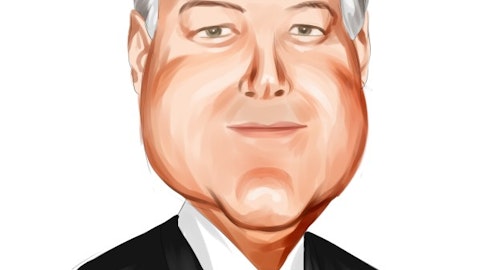Steve Byrne: I asked about the cross-selling, because one of the takeaways for us from the events you had in Cleveland with Construction Products was an apparent awareness that cross-selling was an opportunity there and just would like to hear your view on that, Frank. Is this an area that you think that RPM has some significant opportunity to cross-sell between businesses, and perhaps, regionally, do you have aspirations for sales ex North America to meaningfully increase above the 20% level that it’s at now?
Frank Sullivan: Yeah. Absolutely. So as you saw in the Investor Day presentation, over the last four years, our internal cross-selling efforts have increased from $60 million annually to $180 million, and certainly, the opportunity for that to double in the coming years exists. One example is, because of the success we have had with Arnette Polymers, which is a pre-polymer raw material resin division of Stonhard and then the Corsicana plant which, while it’s part of our Construction Products Group, today is principally serving Consumer and Rust-Oleum. We are utilizing the leadership there to create a resin center of excellence in Europe to create the same type of stability and certainty in supply, competitive advantage in raw materials and cost selling and that’s going to play out over the next 12 months or 18 months.
So that’s one of many concrete examples of trying to continue to accelerate what’s been a pretty good story in terms of intercompany supply and/or cross-selling revenue benefits.
Steve Byrne: Thank you.
Operator: And our next question will come from Ghansham Panjabi with Robert W. Baird. Please go ahead.
Frank Sullivan: Good morning.
Ghansham Panjabi: Hi, guys. Good morning and Happy New Year as well.
Frank Sullivan: Thanks.
Ghansham Panjabi: I guess, Frank, on the inventory adjustment dynamic, as you kind of think about it, do you see this as sort of a multi-quarter phenomenon or one that’s going to disproportionately impact one of your smaller quarters, which is 3Q and then things sort of normalize from there? And then just related to that, just given all the complexity in the current operating environment, is there any historical payrolls that you can think of that are sort of equivalent to what you are seeing at this point?
Frank Sullivan: Sure. Thank you. It will have a disproportionate negative impact on Q3 and that’s certainly part of our guidance. As you trying to ramp down production in this case in a few specific areas to address inventory imbalances as opposed to absolute demand and I had commented earlier about the overhead absorption hit. It will be less in Q4 and into Q1. I think it will take another six months or nine months for us to get inventory back to where we want. It’s just a slow and steady progression. But you are already seeing this. Our inventory levels quarter-over-quarter on a relative days basis haven’t improved much. But there’s been a significant shift from what was a higher-than-usual carrying of raw material inventory into finished goods, which is obviously the cash conversion cycle that we like to see.
Now we got to sell it and turn it into cash. And I have never seen — we have talked about destocking in the past when some of our big consumer customers would work to get to the next level of inventory stock efficiency and that certainly happened to us and people have talked about its impact circumstantially when it’s happened. In my career, I have never seen the supply chain disruptions and then related inventory imbalances. And so, for instance, there were there was demand we couldn’t meet in some of our Consumer businesses over the last year because of these things. So we would have certain customers order in excess more than what they probably needed because they wanted to get what they could sell. We had customers in our Construction Products Group over the last year going to the same thing.
So you just had odd circumstances across multiple businesses and channels and industries in terms of order flows caused by this supply chain disruption and with a settling down of supply chains, which I think were back to normal, now you are seeing people try and modulate back into a normal inventory level and a refocus on working capital position back to something that’s more normal and more stable and more predictable.
Ghansham Panjabi: I know there’s a lot going on. And for my second question, in terms of your comments related to the weakening in volumes late in the quarter, which specific businesses and end markets were the most impacted, I know you called out new construction, but just more color on that?
Frank Sullivan: Sure. As we think about Q3 going into the spring, we saw solid performance from our Consumer Group and we would expect to see that continue. We saw really solid performance in our Performance Coatings Group and given their infrastructure function and focus and heavy industry focus and some of the onshoring and infrastructure dollars out there, we expect that to continue. The weakness was really in the Construction Products Group at particularly as we start Q3. I can’t tell you sitting here whether it’s a sustained weakness that’s continuing that’s more recession like or whether some of it was a result of the winter storm that impacted all North America. We saw weakness in the OEM portion of our Specialty Products Group or our Specialty Products Group is about $800 million, about half of that is OEM coatings, powder coatings, liquid metal, wood stains and finishes, and again, some of that could be circumstantial.
Over the last couple of years, the normal between Christmas, New Year shutdowns that some of our cabinet maker customers, door customers, RV customers had traditionally, they did not have, well, they had those again this year and some of that is extending into January. And how much of that is in anticipation of continuing recessionary pressure as opposed to some of these inventory adjustments we won’t know for another month or 2.
Ghansham Panjabi: Thanks so much, Frank.
Frank Sullivan: Thank you.
Operator: And our next question will come from Jeff Zekauskas with JPMorgan. Please go ahead.
Jeff Zekauskas: Thanks very much. Your
Frank Sullivan: Good morning.
Jeff Zekauskas: Hi. Good morning. Your corporate costs are annualizing at $132 million versus something like a little less than $100 million last year and even in 2021, maybe your corporate costs were $113 million. What’s going on there? Is this a large onetime increase for this year or is it something more permanent? Why are corporate costs up so much?





